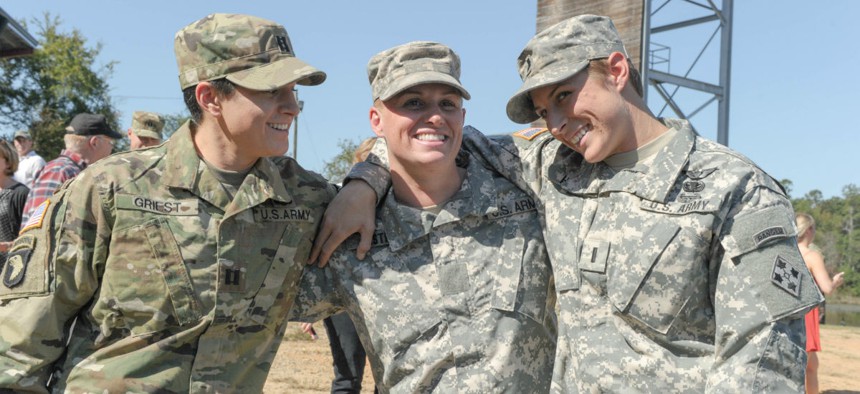The ban on women in ground combat, which stood in some form ever since women were first permanently integrated into the U.S. military in 1948, has been lifted and all combat roles are now open to women. Since Defense Secretary Ash Carter announced the new policy last December, the American military has also seen women ascend to positions in its highest ranks: Air Force General Lori Robinson became the country’s first female combatant commander, and Admiral Michelle Howard became the first female four-star admiral. It’s possible that a woman will soon, and for the first time, become the commander-in-chief of America’s armed forces.
Yet as much attention as some of these “firsts” have won, a quieter—and in some ways even more dramatic—shift is happening further down the ranks, as women stand poised to take command of combat units for the first time. In April, West Point graduate and Army Captain Kris Griest became the first female infantry officer; 22 other young women have been commissioned as infantry and armor officers following their graduation from West Point, officer candidate, and Reserve Officers’ Training Corps (R.O.T.C.) programs across the U.S. These are the combat units that until this year remained off-limits to women in the armed forces. These women still have officer-leader courses to complete before they actually take command of any troops.
But if they do pass, they would be in line to become platoon leaders in battalions that have seen a great deal of combat, and casualties, this past decade of war in Iraq and Afghanistan. While the U.S. military is currently deployed in far fewer numbers than during the height of the post-9/11 wars in the Middle East and South Asia, the tide of war has not yet receded, as U.S. President Barack Obama said it was doing back in 2011. The next time American conventional forces deploy, young women officers might, for the first time in American history, lead infantry soldiers into battle.
This is the outcome of a gradual process that accelerated over the past 15 years, as the United States looked for the best people it could find fit, able, and willing enough to go into battle on the country’s behalf following the attacks of September 11. Women were among those answering the call: They currently make up roughly 15 percent of America’s active-duty military. As a 2011 report from the Pew Research Center noted, between 1973 and 2010, the number of active-duty enlisted women grew from 42,000 to 167,000. Close to 300,000 women are estimated to have deployed to the post-9/11 wars in Iraq and Afghanistan—that is compared to the approximately 41,000 women deployed in the Persian Gulf War. More than 160 women have been killed in action in these last 15 years of war.
America’s view of its soldiers has been evolving, from World War II through to Korea and Vietnam and the first Gulf War. And today the view of who leads American forces on the ground is on the verge of reflecting today’s battlefield realities when it comes to women: They have been there for years and now their gender will no longer bar them from the opportunity to earn a chance to lead. Yet women at the center of this story, when I’ve spoken to them, have made it clear they have not set out not to prove any point. They don’t want to be “female leaders”—they just want to lead.
And to see everyone. Servicewomen have been recruited to serve on Female Engagement Teams and Cultural Support Teams in Afghanistan and Iraq in order to search and question women in those countries without giving cultural offense. The knowledge they have gained has saved American lives. Recently U.S. special-operations teams that include women have reported back on the situation facing Syrian women living under ISIS, as special-operations sources told me recently. When women are on the battlefield, particularly in countries where tradition and culture make it difficult for male soldiers to speak to local women, access to the entire population—and the knowledge and understanding that population possesses—is suddenly possible. But the female-engagement role is not the job most women in uniform fill. And now there are no roles that remain officially men-only.
In some ways, the rise of female combat officers is even more historic than the graduation last fall of three women from Ranger School, the Army’s premier leadership course that tests the physical mettle and mental strength of those who attempt it. While their achievement showed that some women could meet one of the military’s most rigorous and demanding tests and meet precisely the same standards as male soldiers, their Ranger School graduation actually guaranteed them little from the Army in terms of future assignments. At the time they graduated, prior to Carter’s changing the combat policy, the 75th Ranger Regiment remained closed to women. They wore the Ranger tab, but could not yet attempt Ranger Assessment and Selection Program.
Now the military—influenced, no doubt, by the performance of women on the front lines of war, in roles ranging from pilots to medics to cultural-support team members and engineers since 9/11, and by these first women Ranger graduates—is on the verge of assigning women to lead young men “outside the wire,” beyond the relative safety of their bases. They will take on the same risks and responsibilities as male officers and, consequently, the same opportunities for promotion. In future years some of these women may make it to company commander, leading 200 combat troops at a time, and perhaps some years after that, some will become battalion commanders, responsible for as many as 1,000 combat troops.
And perhaps they may one day find themselves in line to reach the brass ring as chief of staff of the Army or even chairman of the Joint Chiefs of Staff, roles traditionally filled by those who led combat units—all men, until now.
Yet even when women were still officially banned from ground combat, they were going out alongside infantry soldiers and special-operations forces. Colonel David Fivecoat served three combat tours in Iraq, led a battalion in Afghanistan, and later oversaw the Ranger training program that included the three female graduates. At the National Infantry Museum, he introduced a book I wrote about an all-women special-operations team recruited for Ranger and SEAL missions back in 2011, and he spoke of “the charade many of us played with the direct ground combat rule. As a battalion commander in Afghanistan ... I put two women to work side-by-side with each and every Rifle Company. Women ... made real contributions in Iraq and Afghanistan.”
Now that the charade is over, the image of who leads the United States in war is about to evolve before the eyes of an entire nation. No doubt this shift will shock the system, at least initially, for those who enlist in the Army every year and form the backbone of the military's largest service, and for the nation in whose name they serve. (The fact that women graduated from Ranger School alone generated a great deal of online heat in and outside of the Ranger community, much of it targeting Fivecoat; Ranger school instructors—some of whom served 13 special-operations deployments—have spoken to me about losing friends who feel certain the women received special treatment.)
But it will shock even more the American public, which has long experienced a great distance from its post-9/11 wars. Women have often been silent bystanders in America’s stories of battle, even as they have taken on an ever-greater share of the fight. They have received silver stars, bronze stars, and purple hearts for their valor. And soon, the debate over whether women can lead and serve with honor will be forced to catch up with the reality: Women have been doing this for more than a decade.




